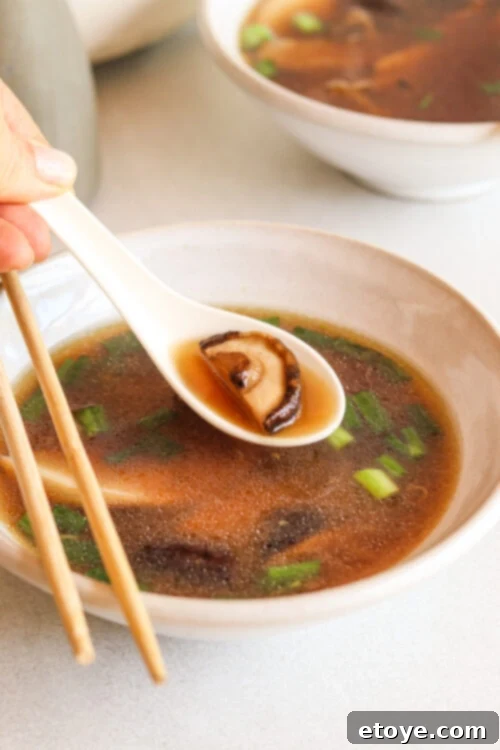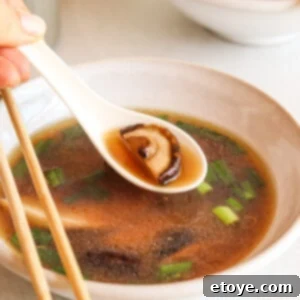Welcome, fellow food enthusiasts! Today, we’re diving into the comforting world of soup, specifically this incredibly simple yet profoundly flavorful Mushroom Miso Soup. Imagine a warm, savory embrace in a bowl, packed with enough umami to transport you straight to your favorite Japanese eatery, all without the daunting bill or complex preparation. This isn’t one of those elaborate recipes that demands a scavenger hunt for obscure ingredients; quite the opposite. It’s designed to be effortlessly satisfying and perfectly achievable, even on those hectic weeknights when you’re teetering on the edge of culinary despair.
Miso soup is a cornerstone of Japanese cuisine, cherished for its simplicity, depth of flavor, and remarkable health benefits. While often served as a prelude to larger meals, this mushroom-infused rendition is hearty enough to stand alone, offering a fulfilling experience that nourishes both body and soul. Its quick cooking time means you can whip up a batch faster than ordering takeout, making it an ideal choice for a wholesome, homemade meal. So, grab your largest soup pot and prepare to unlock the secrets of this delicious, immune-boosting wonder.

Why This Easy Mushroom Miso Soup Recipe is a Must-Try
This mushroom miso soup isn’t just another recipe; it’s a culinary triumph designed for modern life. Here’s why it deserves a permanent spot in your rotation:
- A Symphony of Umami: The magic of this soup lies in its incredible depth of flavor, primarily from the harmonious blend of diverse mushrooms, rich soy sauce, and fermented miso paste. Umami, often described as a savory “fifth taste,” elevates this soup from good to extraordinary, providing a satisfying richness that lingers delightfully on the palate. It’s a taste experience that feels gourmet, yet is surprisingly easy to achieve.
- Incredibly Quick and Effortless: From the moment you start chopping to the first satisfying slurp, you’re looking at a mere 20 minutes. This makes it an absolute lifesaver for busy weeknights when time is a luxury. Its straightforward process means less stress and more enjoyment, proving that healthy, delicious meals don’t have to be time-consuming.
- Flexible and Adaptable Ingredients: Don’t have shiitake mushrooms on hand? No problem! This recipe is wonderfully forgiving. Feel free to swap them for cremini (baby bella), oyster, or even simple button mushrooms. The key is to use what you have, making it accessible and convenient without a special trip to the grocery store. This flexibility encourages creativity in the kitchen, allowing you to tailor it to your preferences or what’s readily available.
- A Boost for Your Immune System: Beyond its delicious taste, this soup is a powerhouse of nutrition. Mushrooms are renowned for their immune-boosting properties, rich in vitamins, minerals, and antioxidants. Miso, a fermented food, introduces beneficial probiotics that support gut health, which is intrinsically linked to a strong immune system. Enjoy a bowl and feel good about nourishing your body.
- Minimal Cleanup for Maximum Enjoyment: Who loves doing dishes? Not many! This recipe simplifies post-meal chores significantly by being a one-pot wonder. All the sautéing and simmering happen in a single pot, meaning your dishwasher (or your hands!) will thank you for the minimal cleanup required. More time to relax and savor your delicious creation!

Key Ingredients and Their Remarkable Benefits
Each component of this mushroom miso soup plays a vital role, not just in flavor, but also in contributing to its wholesome goodness:
- Mushrooms (The Umami Stars): Our recipe calls for a mix, and for good reason. Shiitake mushrooms offer a rich, smoky depth; shimeji provide a delicate, slightly nutty flavor; and oyster mushrooms contribute a tender, meaty texture. Beyond taste, mushrooms are packed with antioxidants, B vitamins, and selenium, known for their immune-modulating properties. Varieties like Maitake and Enoki can also be fantastic additions for even more complex flavors and textures.
- Miso Paste (The Probiotic Powerhouse): This fermented soybean paste is the heart and soul of miso soup. It provides a unique savory, salty, and slightly sweet flavor profile. More importantly, miso is a fantastic source of probiotics, beneficial bacteria that promote healthy digestion and gut flora. White miso (shiro miso) offers a milder, sweeter taste, while red miso (aka miso) is bolder and saltier, offering a deeper umami punch. Choose according to your preference!
- Dashi or Vegetable Broth (The Flavor Foundation): Dashi, a traditional Japanese stock made from kombu (kelp) and bonito flakes, provides a clean, oceanic umami base. If you’re keeping it vegetarian or vegan, a high-quality vegetable broth works beautifully, adding its own layer of savory depth without compromising the soup’s integrity. Mushroom broth is another excellent vegetarian alternative that enhances the earthy mushroom flavors.
- Soy Sauce (The Salty Enhancer): A splash of soy sauce deepens the savory notes and provides essential saltiness, balancing the rich flavors of the miso and mushrooms. It acts as a liquid seasoning, harmonizing all the ingredients. For a gluten-free option, tamari can be used interchangeably.
- Green Onions (Freshness and Zest): Both the white and green parts of green onions (scallions) are crucial. The white parts, lightly sautéed, add a subtle oniony sweetness, while the green tops, added at the end, provide a fresh, peppery bite and vibrant color, elevating the soup’s overall presentation and flavor.
- Fresh Ginger (The Zingy Kick): Freshly crushed ginger introduces a warm, slightly spicy, and incredibly aromatic element. It not only brightens the rich broth but also offers anti-inflammatory benefits and aids digestion, making the soup even more comforting and invigorating.

Ingredients for Your Perfect Mushroom Miso Soup
Gather these simple ingredients, and you’ll be on your way to a delightful bowl of homemade miso soup:
- 1 Tbsp Peanut Oil (or sesame oil for a nutty flavor)
- 250g Mushrooms (a mix of shiitake, shimeji, and oyster mushrooms for best flavor, but any will do!)
- 1 clove Garlic, thinly sliced
- 1 tsp Fresh Ginger, crushed or finely grated
- 4 cups Dashi or high-quality Vegetable Stock
- 4 Tbsp Miso Paste (white miso for mild, brown for bold)
- 2 Tbsp Soy Sauce (or tamari for gluten-free)
- ¼ cup Green Onions, finely sliced (for garnish and flavor)
Smart Substitutions to Customize Your Soup
Part of the beauty of this mushroom miso soup recipe is its adaptability. Don’t hesitate to make it your own with these smart swaps:
- Dashi Alternatives: If traditional dashi isn’t readily available, fear not! Vegetable broth is an excellent and widely accessible vegetarian option. For an even deeper earthy flavor, consider using mushroom broth. You can also make a quick vegetarian dashi by simmering a piece of kombu (dried kelp) in water for 15-20 minutes.
- Oil Choices: Peanut oil provides a neutral base that allows the other flavors to shine. However, if you’re looking for an extra layer of nutty aroma, toasted sesame oil is a fantastic substitute. Olive oil or avocado oil can also work in a pinch for sautéing.
- Mushroom Varieties: The world of mushrooms is vast and wonderful! While a mix of shiitake, shimeji, and oyster offers complexity, feel free to use what you have. Cremini (baby bellas), button mushrooms, portobello, or even dried mushrooms (rehydrated in hot water and then sliced) will all contribute their unique textures and flavors. Just ensure you get about 250g total.
- Miso Paste Variations: White miso (shiro miso) is the most common and offers a mild, slightly sweet flavor. If you prefer a richer, more robust profile, opt for red miso (aka miso) or brown miso. These darker misos are fermented longer and provide a more intense umami. Keep in mind that darker misos are saltier, so you might adjust the soy sauce slightly.
- Soy Sauce Alternatives: For those avoiding gluten, tamari is a perfect 1:1 substitute for soy sauce. If sodium is a concern, use a low-sodium soy sauce.

Step-by-Step Instructions for Your Perfect Mushroom Miso Soup
Follow these simple steps to create a soul-warming bowl of mushroom miso soup:
- Sauté the Mushrooms to Perfection
Heat the peanut oil in a large pot or Dutch oven over medium heat. Add your chosen mix of mushrooms and sauté for about 5-7 minutes. Stir occasionally until they release their moisture, start to brown beautifully, and develop a lovely tender-crisp texture. Once ready, scoop the sautéed mushrooms out of the pot and set them aside. Resist the urge to snack on them all just yet! - Infuse with Aromatics
To the same pot, add the sliced garlic and crushed ginger. Sauté for 2-3 minutes, stirring constantly, until they become fragrant. Be careful not to burn the garlic. Your kitchen should now smell absolutely divine! - Build the Broth Base
Pour in the dashi or vegetable broth, then stir in the soy sauce. Bring the mixture to a gentle boil over medium-high heat. Once boiling, reduce the heat to low, cover the pot, and let it simmer for 3 minutes. This allows the flavors to meld beautifully. - Unlock the Miso Magic
Crucially, turn off the heat before adding the miso paste. Miso contains beneficial probiotics that can be destroyed by high heat. To ensure it dissolves smoothly, scoop a small amount of the hot broth into a separate small bowl. Add the miso paste to this small bowl and whisk until it’s completely smooth and lump-free. Then, stir this miso mixture back into the large pot of broth. - Finish Strong and Serve
Return your sautéed mushrooms to the pot. Stir in most of the finely sliced green onions, reserving a small amount for garnish. Give everything a gentle stir, then ladle the hot soup into individual bowls. Garnish with the remaining fresh green onions and serve immediately. Enjoy the rich, savory flavors of your homemade mushroom miso soup!
Expert Tips for the Most Flavorful Mushroom Miso Soup
Achieving restaurant-quality flavor at home is easier than you think with these expert tips:
- Never Boil the Miso: This is perhaps the most important rule of authentic miso soup. Miso paste is a living food, rich in beneficial enzymes and probiotics. Boiling it will not only kill these valuable compounds but also dull its delicate flavor. Always stir miso into the soup after you’ve removed it from the heat.
- Opt for Fresh, High-Quality Mushrooms: The type and freshness of your mushrooms will significantly impact the soup’s overall flavor and texture. While dried mushrooms can be rehydrated and used, fresh, varied mushrooms offer a more vibrant and nuanced taste. Look for firm, unblemished mushrooms at your local market.
- Don’t Skip the Sauté Step for Mushrooms: Sautéing the mushrooms before adding them to the broth helps them develop a deeper, more caramelized flavor. This browning process, known as the Maillard reaction, enhances their natural umami and creates a more robust soup base.
- Customize to Your Heart’s Content: This recipe is a fantastic starting point, but don’t hesitate to personalize it!
- Add Noodles: Soba or ramen noodles can transform this into a heartier meal.
- Protein Boost: Cubes of silken tofu, shredded cooked chicken, thinly sliced pork, or a soft-boiled egg make excellent additions.
- More Veggies: Wilt in some baby bok choy, spinach, Napa cabbage, or sliced carrots during the last few minutes of simmering.
- Spicy Kick: A dash of sriracha or a pinch of red pepper flakes can add a welcome warmth.
- Storage and Reheating: Leftover mushroom miso soup can be stored in an airtight container in the refrigerator for up to 3 days. When reheating, do so gently on the stovetop over low heat, or in the microwave. Avoid boiling, especially if the miso was added off the heat initially, to preserve its beneficial properties and flavor.

Frequently Asked Questions About Mushroom Miso Soup
Here are answers to some common questions about making this delicious soup:
Q: Can I make this soup vegetarian or vegan?
Absolutely! Simply ensure you use vegetable broth or mushroom broth instead of dashi if it contains bonito flakes. The rest of the ingredients are naturally plant-based, making it a perfect vegan and vegetarian dish.
Q: Where can I find miso paste?
Miso paste is becoming increasingly common in most well-stocked grocery stores, often found in the refrigerated section near tofu, international foods, or specialty cheeses. Your local Asian market is always your best bet for a wider selection and usually better prices.
Q: What’s the best kind of mushroom for this soup?
A variety of mushrooms offers the most complex and rich flavors. We recommend a mix of shiitake, shimeji, and oyster mushrooms. However, cremini (baby bellas), button mushrooms, or even lion’s mane mushrooms would also be excellent choices, each bringing a unique texture and flavor profile.
Q: Can I freeze this soup for later?
While technically possible, freezing this particular soup isn’t recommended for optimal flavor and texture. The delicate nature of miso paste and the texture of mushrooms tend to degrade upon freezing and reheating, leading to a less satisfying experience. Luckily, it’s so quick to make fresh that you can easily whip up a batch whenever a craving strikes!
Q: What if I don’t have fresh ginger?
While fresh ginger provides the best flavor and benefits, you can substitute it with about ½ teaspoon of ground ginger powder. Add it with the broth and soy sauce to ensure it dissolves well. However, for that bright, zingy kick, fresh is always preferred.
Making This Soup Your Own? Share Your Creations!
We believe cooking is an art form, and this easy mushroom miso soup is a fantastic canvas. Whether you’ve added a unique vegetable, a special protein, or a secret spice, we’d love to hear how you’ve customized this delicious recipe to fit your personal taste. Your innovations inspire us all! Leave us a comment below and share your creative twists – let us know how you make this miso mushroom soup uniquely yours.
Easy Mushroom Miso Soup Recipe
This comforting soup masterfully combines a delightful mix of earthy mushrooms, savory miso paste, and a rich dashi or vegetable broth for the ultimate umami-packed experience. With the aromatic additions of garlic, fresh ginger, soy sauce, and a vibrant sprinkle of green onions, it’s a dish that is both simple to prepare and incredibly satisfying. Ready in just 20 minutes, this healthy and delicious soup is perfect for any meal, any time of the year.

Quick Glance
- Prep Time: 10 mins
- Cook Time: 10 mins
- Total Time: 20 mins
- Course: Dinner, Lunch, Sides
- Cuisine: Asian, Japanese
- Servings: 4 people
- Calories: 126 kcal
- Keyword: broth, miso soup, mushroom, quick soup, vegetarian
Ingredients
- 1 tbsp peanut oil
- 250 grams mushrooms (a mix of Shiitake, oyster, shimeji is recommended for best flavor)
- 1 clove garlic, sliced
- 1 tsp fresh ginger, crushed
- 4 cups dashi (or vegetable broth for a vegetarian option)
- 4 tbsp miso paste (white or brown, depending on desired boldness)
- 2 tbsp soy sauce (or tamari for gluten-free)
- ¼ cup green onions, finely sliced
Instructions
- Heat the peanut oil in a large pot over medium heat. Add the mushrooms and sauté for about 5-7 minutes until they are lightly browned and have released their juices. Remove the mushrooms from the pot and set aside.
- Add the sliced garlic and crushed ginger to the same pot. Sauté for another 2-3 minutes until fragrant, being careful not to burn them.
- Pour in the dashi (or vegetable broth) and stir in the soy sauce. Bring the pot to a gentle boil, then reduce the heat to low and let it simmer, covered, for 3 minutes to allow the flavors to deepen.
- Turn off the heat. Scoop a small amount of hot broth into a separate small bowl. Add the miso paste to this small bowl and whisk until it is completely smooth and free of lumps. Then, stir this dissolved miso mixture back into the main pot of broth. (Remember: do not boil the miso!)
- Return the sautéed mushrooms to the pot. Stir in most of the finely sliced green onions, reserving a small amount for garnish. Serve warm and enjoy your delicious homemade mushroom miso soup!
Nutrition Information (per serving)
- Calories: 126 kcal
- Carbohydrates: 9g
- Protein: 10g
- Fat: 6g
- Saturated Fat: 1g
- Polyunsaturated Fat: 2g
- Monounsaturated Fat: 2g
- Sodium: 1917mg
- Potassium: 486mg
- Fiber: 2g
- Sugar: 3g
- Vitamin A: 87 IU
- Vitamin C: 3mg
- Calcium: 93mg
- Iron: 2mg
